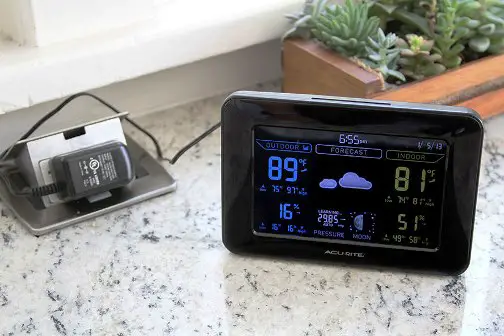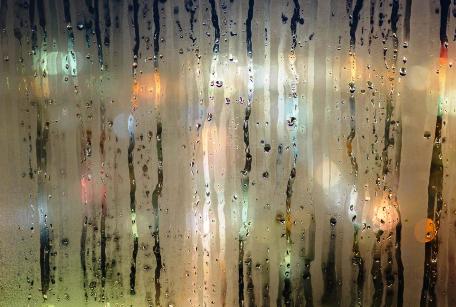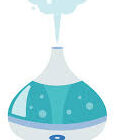How Outdoor Humidity Affects Indoor Humidity and What To Do About It
Does outdoor humidity affect indoor humidity, and to what degree?
Of course, it does! No matter how airtight your home is, the air from outside will always enter. Humidity makes us feel awful. That is why it is such a huge concern.
If the humidity is high outside, it will change your indoor humidity level.
If the humidity outside is low, the dry air will enter through gaps in the panels, windows, and doors. It might be by a small margin, but it’ll change the humidity level.
Indoors, you have more control over the humidity level by using a humidifier or dehumidifier. You can also control the temperature.
Does outdoor humidity affect indoor humidity?

Living in high humidity has effects on your health. That’s why you need to keep the level of air moisture indoors in the range of 30 to 55 percent.
If humidity rises any higher than that, you can experience serious sickness symptoms.
Likewise, if the humidity level falls below 30 percent, you can experience serious symptoms of sleeping in dry room. These include inflammation of the airways, cracked skin, frizzy hair, and dehydration.
The high humidity outside affects the humidity inside. At home, we keep opening and closing doors and windows.
In one article, we asked whether you can run an air purifier with the windows open. Well, if you do that, you will overwork it since more contaminated air keeps coming in.
It is the same thing for a humidifier or dehumidifier. If you use them in a room with the windows open, you may have to run the dehumidifier for too long.
To control the effect of outside humidity over inside humidity, start by closing windows and doors. No air from inside escapes, and no air from outside gets in.
What is considered to be high humidity outside?

Before you head outside for the day in the morning, check the hygrometer to see the current humidity level.
Precisely, check the dew point, since it is more accurate than the relative humidity level. If the dew point is above 65 degrees Fahrenheit, it is going to be a damp day.
If the dewpoint is above 70 degrees Fahrenheit, you are going to have a swampy day. The humidity will be overwhelming.
Usually, we experience high dewpoint in the summer in most places. However, in a state like Florida, you can have high humidity levels all the time.
Even if you will not be going outside, you still need to know what the outside humidity is. The outdoor humidity and temperature will affect your indoor humidity levels.
When the high humidity outdoors finds its way indoors, it will damage your electronics, paintings, furniture, and carpets.
Since there is not much you can do to control the humidity level outside, you can only try to keep the humid or dry air outside.
That way, it will not affect your indoor humidity too much.
High humidity in winter outside
Some places are both cold and humid at the same time. In most other places, winter causes low humidity both outdoors and indoors.
Cold air does not have much capacity to hold water.
Indoors, the humidity level drops because you run the furnace to keep the air warm. The heat from the furnace makes the indoor air drier.
If you have integrated a whole-house humidifier into the furnace, it will adjust the humidity automatically. This is vital because dry air indoors causes static electricity, nosebleeds, sore throats, headaches, chapped lips, and others.
If you have been wondering whether a whole-house humidifier is a bad idea, it is not. It can increase humidity automatically to the set levels in winter.
Check the dewpoint on the hygrometer in winter. Dewpoint is the temperature at which water vapor turns into dew.
The dewpoint temperature for winter can be as low as 30 degrees Fahrenheit. You’ll experience the symptoms of dry air because the most comfortable humidity level is achievable at a dewpoint of 55 to 60 degrees Fahrenheit.
Consider this… when the temperature is 0 degrees Celsius, a cubic meter of air contains about 5 grams of moisture. That’s super dry!
If the temperature rises to 15 degrees Celsius, a cubic meter of air will contain 13 grams of moisture. If you increase the heat higher than this, the relative humidity will start to drop.
High humidity outside and inside

You can have higher humidity inside than outside. You can tell this by a few signs. If you see condensation on your windows, it means the humidity inside is high.
Temperature affects humidity. Therefore, when you are comparing indoor vs. outdoor humidity, you must consider the temperature.
If you increase the temperature of the air indoors, the humidity drops. Warm air, as in summer, can hold more moisture. However, indoors, running the furnace will suck all the moisture from the air.
In a place that experiences humid winters, when the temperature is 0 degrees Celsius, the relative humidity level is 100 percent. The weather will be foggy.
However, 0 degrees Celsius outside is 0 degrees Celsius inside, so you have to heat the indoor air for your comfort.
As soon as you raise the indoor temperature to, say, 20 degrees Celsius, the inside humidity drops to 22 percent or thereabouts.
Most places experience dry winters. In such places, when the outdoor temperature is 0 degrees Celsius, the humidity level can be 30 percent.
Without running the furnace, this will be the temperature and humidity of your indoor air. Once you heat the air to 20 degrees Celsius, the humidity can drop to as low as 6 percent.
This is why we use humidifiers in winter, because we need to raise the humidity level. If you ignore this, you will find the air too dry, and there will be static, nosebleeds, and sore throats.
Recommended indoor humidity based on outside temperature

There is a relationship between temperature and humidity. If the outside temperature rises or falls, you must adjust your indoor humidity.
In winter, the indoor humidity level needs to rise. That’s why we run the humidifier.
In summer, we use a basement dehumidifier to remove extra moisture from the air because the humidity level is really high.
From this alone, you can see how temperature affects humidity. In winter, a good humidity level is between 40 and 60 percent. When it is summer, keep the humidity level between 30 and 50 percent.
Here’s a simple tabular representation of the recommended relative humidity level for certain temperature levels:
| Outdoor temperature (degrees Celsius) | Recommended humidity level indoor |
| Less than -6.6 | 15 percent |
| -6.6 | 35 percent |
| -23 | 25 percent |
| -12 | 30 percent |
| 4.4 | 40 percent |
Why humidity is higher inside than outside?
The inside humidity level can be higher than the outside level due to a few factors, which are as follows:
Poor ventilation
If there is poor ventilation, the humid air inside will not escape easily. Because of breathing, cooking, showering, and other activities, you can whip up quite a bit of humidity indoors.
You might have to install an exhaust fan for the bedroom or bathroom to remove the extra moist air.
When too much air from outside comes in, it will eventually contribute to increasing the humidity indoors.
With old houses, the windows might be allowing in too much air. If that’s the case, you need to weatherstrip the windows.
Cooking, laundry, and bathroom
The kitchen, laundry room, and bathroom are the humidity generators in your home. There is not much to do about these areas because you must use them. However, you can install exhaust fans to help with the air exchange.
You can also run a portable dehumidifier to lower the humidity level.
In grow rooms
If you have a grow room or a growth tent, it can generate too much humidity from the plants as respiration takes place. Our article on how to control humidity in grow tent can teach you everything you need to know.
While at it, you can also learn a couple of things about how to lower humidity in an incubator.
Final thoughts: Does outdoor humidity affect indoor humidity?
To the question of: Does outdoor humidity affect indoor humidity? The answer is a resounding yes.
Even outdoor temperatures affect indoor humidity. To be comfortable in your house, check the dewpoint on the hygrometer.
If the dewpoint starts pointing below 40 degrees Fahrenheit, the air will become too dry for your health. Likewise, if the dewpoint rises above 60 degrees Fahrenheit, you will have a swampy day.
To control inside humidity properly, you need to have a dehumidifier and a humidifier. You also need to seal your house properly so that most of the outside air does not find its way in.

